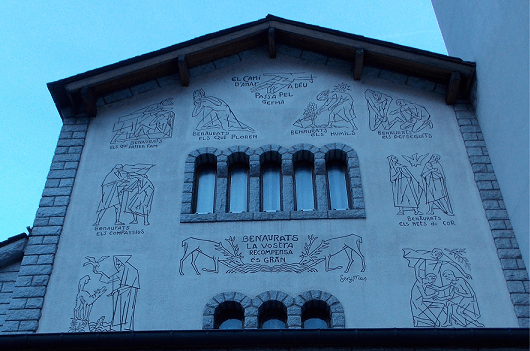PICK OF THE WEEK: Andorra (Pyrenees)
Main places:
Andorra la Vella, Escaldes-Engordany
5th ANDORRA INTERNATIONAL SAX FEST 2017.
THIS IS A REMARKABLE OPPORTUNITY FOR ALL SAX LOVERS!
From Monday, 17th to Saturday, 22nd April, the 5th edition of the Andorra Sax Fest, one of Europe’s most important saxophone festivals, will be playing out in the country’s capital, Andorra la Vella. Master Classes with Vincent David and Arno Bornkamp, Workshops, Concerts and Competitions: for Soloists, Walking Street Music and Young soloists alike. All dedicated to the instrument that the Belgian Adolphe Sax presented to the world in 1840. At the heart of the festival is the IV International Solo Saxophone Competition, open to young players under 30 from around the world. All sessions are open to the public. Collect a full programme from the Andorra la Vella Tourist office. Meanwhile, for the main concerts (most of them free) see PICK OF THE WEEK below.
SANT JORDI: THE FESTIVAL OF THE BOOK AND THE ROSE
(An extract from the book Andorra Revealed)
23rd April, St George’s Day (Sant Jordi to Andorrans) and our Andorra Writers’ Group has reserved a stand in the Plaça del Poble, the capital’s main square. Tradition dictates that today all the females of Andorra and Catalonia, from little girls to old ladies, present a book to their favourite males: be they lover, teacher, father or grandson. It is also the day when all the males of the species are expected to present the females closest to their hearts with a single, wine-red rose.
The Day of the Book and the Rose indeed! Surely the world’s most civilised festival with its symbols of wisdom, culture and love.
Sant Jordi is the day when the bookshops – and the authors – of the region expect to make a killing. As I write, throughout Catalonia they are hoping to sell a whopping 800,000 books, half their annual turnover, in just one or two days. Not so long ago, when Andorra’s total population stood at 65,000, Andorran males bought 70,000 red roses. Tradition writ large!
My diminutive 4×4 van is already stacked high with fruit-crates of second-hand books and, naturally, in this polyglot country, they come in a choice of four languages: Catalan, Spanish, French and English. They are to be sold at 1€ each for the local charity, “Infants del Món”. There is also one box, more gently nurtured, full of new volumes of the books we have written ourselves. This year our small group has more titles than ever on sale: two joint anthologies Andorra Revealed and Andorra: Festivals, Traditions and Folklore while individual works include Patricia Grey’s Death Has a Thousand Doors and Thirteen Families, Jeanne de Ferranti’s The Journey That Never Was, Alexandra Grebennikova’s Les Bicicletes No Es Mengen, and Clare Allcard’s Living Afloat, A Gypsy Life and Rodamons de la Mar. We also have past member, Cathy O’Dowd’s Just For The Love Of It about climbing Mount Everest and Clare’s husband, Edward Allcard’s latest book Solo Around Cape Horn and Beyond published a couple of months ago at the age of 102.
But from whence comes this remarkable custom of the book and the rose? In centuries past, St George was one of Christendom’s most popular patron saints, and even today he not only keeps watch over Catalonia but England, Ethiopia, Georgia, Portugal, Russia, Ukraine, and a dozen countries more …. It was he who, born in Palestine, rode to the defence of a city – some say in the Middle East – besieged by a man-eating Dragon. Each day the citizens drew lots to see who next would be fed to the beast. Finally the lot fell to the king’s own daughter. The beautiful princess had already been chained to a rock, waiting to be devoured, when St George rode to the rescue astride a white charger – naturally. George promised the citizens that, if they would only convert to Christianity, he would slay the Dragon and rescue the princess. According to legend, they did – and he did.
As far back as 1463, Catalonia celebrated Sant Jordi as the Day of the Rose, the day of lovers, a Catalan St Valentine’s. On the same day in the 19th century members of the Catalan parliament in Barcelona would honour the women who worked for them with red roses.
The van and I hurtle ever downwards, skimming through the lower gears as we approach the hairpins, speeding up on the straights, the crates in the back swishing back and forth as we go.
Arriving at the Plaça del Poble – in fact the roof of the government administration building – we weave cautiously across the square not wanting to add stall-holders’ blood to that once spilled by the infamous Dragon. Stopping beside our stand, I begin to unload: cloths to cover the tables on loan from the local council, an essential Andorran blue, gold and red tricolour to pin to the stall front, signs in Catalan and English, price tags, Sellotape. Add to that, thick blankets against the cold, swathes of plastic sheeting against possible rain, thermoses of hot coffee, plastic carrier bags full of – well, more plastic carrier bags, bum bags with spare change and, of course, books. Oh, and finally, packets of particularly scrumptious chocolate biscuits as morale-boosting comfort food.
For Sant Jordi, coming early in the year, can be a challenge even to the most hardy soul. It is quite common for an icy wind, straight off the capital’s encircling white peaks, to chase across the square unsettling the books, colliding with buckets of roses and freezing the sellers to the bone. Of course there have been blessed occasions when the sun has blazed down to curl up the edges of the paperbacks, wilt the roses and send sellers searching for their sunscreen. And indeed, this year, if the forecast is right, we could be in for anther glorious sunny day!
Already holders of some two dozen stands are in the process of rapid transformation, for all has to be in place to greet the capital’s Mayor and her entourage of ministers and TV cameramen, by 10am.
So where did the idea of the books come from and what was the connection with Sant Jordi? In 1923, the Catalan parliament decided to include books in the ceremony of the rose. Why the 23rd of April? Because the 23rd April was the day, in 1616, that the great Spanish writer, Miguel de Cervantes, father of the European novel and author of Don Quixote, and the great English playwright, William Shakespeare, both died. At least that’s the idea. Dig a little deeper and you will discover that in fact it was the day Cervantes was buried. He died on the 22nd. Dig deeper still and you will unearth the fact that, as the Spanish were already using the Gregorian Calendar and the English still clinging to the ancient Julian one, Cervantes actually died 11 days before Shakespeare, who not only died but was also born on the 23rd April – Julian Calendar.
Now other members of our writers group appear and we rush to be ready for inspection. Beside us, sixth formers from the country’s secondary schools turn up with buckets full of red roses, each bloom accompanied by a piece of wheat for fertility and all carefully wrapped in clear plastic and tied with a patriotic blue, gold and red ribbon. At 4€ a bloom, their roses do not come cheap but all the profit goes towards the class’s summer outing.
Next, the crocodile processions arrive. Minute infants out of kindergarten, identified by florescent tabards emblazoned with their school’s name, are kept together by a long rope from which gaily coloured cotton loops dangle down on either side. Each child has one tiny wrist held in a loop and the other hand free. With a teacher at the front to lead and at the back to scoop up any that might break free, they make an adorable and encouraging sight on their very first cultural outing. As they meander wide-eyed past the stalls they occasionally reach up to touch a book or gaze with longing at the velvety roses decorating our stall. Clearly Andorran educators have taken the dictum, ”Give me a child until he is seven and I will give you the man.” to heart.
Throughout the day “UNESCO Andorra” organises cultural events: maybe they have invited the parish’s Giants, Charlemagne and Ermessenda, to dance. Made of papier mâché, King Charlemagne is 3.5 metres tall and weighs 50 kilos. Getting him to dance and pirouette requires considerable strength and skill. Or maybe members of the passing public are invited to come to the microphone to read a page or two from one of the books being launched that day until, by the end of the afternoon, a whole work has been read aloud.
The public arrives in waves: 10am, lunchtime and then a final surge between 6 and 8pm though with Sant Jordi landing on a Sunday this year we have hopes of a constant stream of punters. Passing eyes shy nervously away from our English titles then settle with relief on boxes of children’s books in French, Spanish and the country’s official language, Catalan. Younger adults rifle through the mound of English paperbacks hoping to find some ‘beach fiction’ to improve their language skills.
By the time evening arrives we are wilting and ready to head home. We pile crates of books, now reduced in number, back into the van, carry our takings from the sale of second-hand books over to the “Infants del Món’s” stall, put away the publicity and fold up the Andorran flag; all ready for the 23rd April next year.
Culturally yours,
Clare
Look for about the author of the blog Clare Allcard
See also Andorra travel guide
See also Pyrenees travel guide
See also France travel guide
See also Spain travel guide











